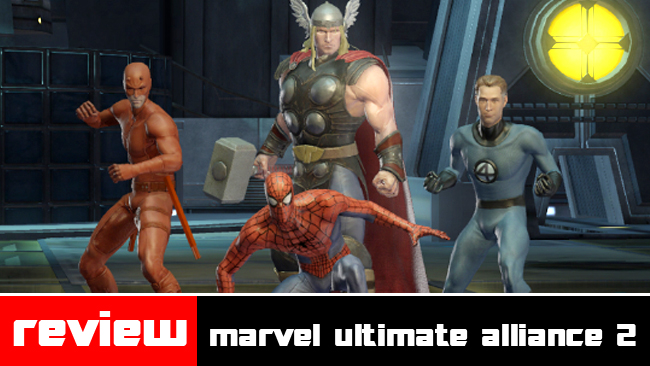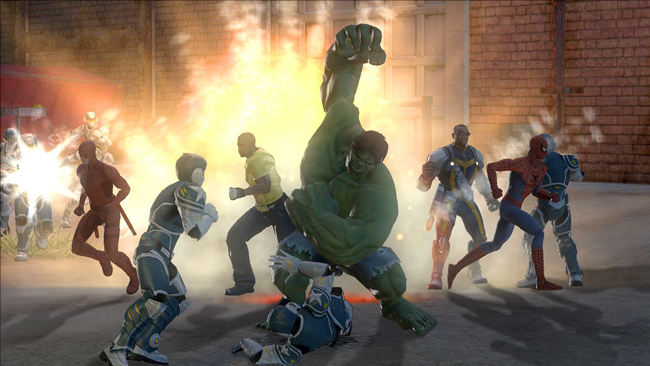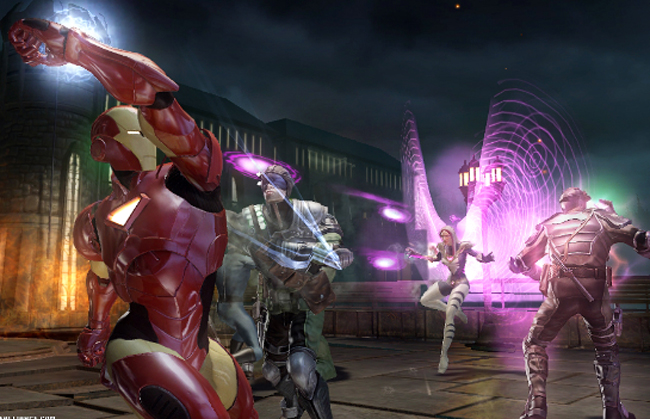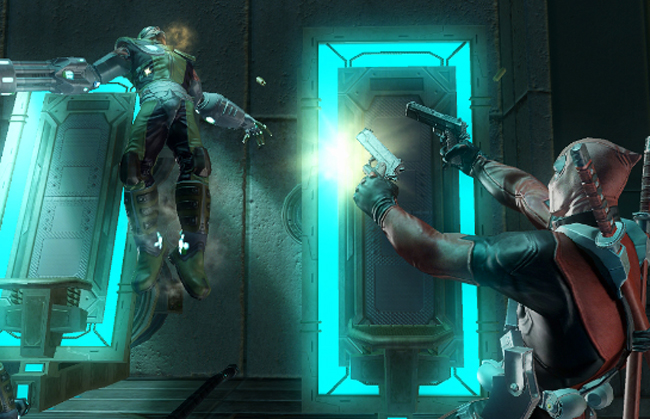
I have to admit: I’ve never been a huge fan of brawlers. Not that I don’t like the design and gameplay mechanic of the genre, but I’ve never really played many that were memorable enough to warrant my attention. The overhead/team brawler genre has always just been there as a gaming staple, not changing much (apart from adding RPG elements in the last few years) and not needing to. “Mindless fun” is my general motto for these games.
When Activision revealed the sequel to one of the best team brawlers this generation in Marvel Ultimate Alliance 2, I was interested to see just how far the genre had come from its humble roots. And with the Marvel license in tow and the Civil War/Secret War storylines mixed in, I was potentially on the verge of Marvel comic overload.

I had never played the successful first MUA (Marvel Ultimate Alliance) because of my aforementioned aversion to the genre. However, fresh off of my revival of interest in modern comic books (it happens every two-three years in my household), I was eager to take the game for a spin. Stuck between having recently finished Uncharted 2 and expecting long bouts of Modern Warfare 2 and New Super Mario Bros Wii through the rest of the year, MUA2 seemed like a perfect gaming palate cleanser.
Game Info
Publisher: Activision
Released: September 2009
Available on: All gaming consoles and hand helds
Rating: T for Teen
The synopsis of MUA2 is as follows: Super team infiltrates hostile country. Country retaliates. Coinciding with several other super incidents, the government passes a law that requires all super humans to register themselves. Heroes and villains take sides. Chaos ensues.
Based loosely on both the Secret War and Civil War story arcs, the events in MUA2 are meant to be weaved together in a slightly more digestible (and action-filled) way. Players take control of a team of four super humans, guiding them through dungeon-crawler missions across lesser-known Marvel locations to complete missions and defeat bosses. Add in a character-building schematic, and you have the popular “RPG-lite” category of gaming. One of the major focuses of MUA2 are two-character fusions, special moves that utilize the super powers of any two characters for incredible damage.

Likes
– Amount of characters: There are 23 selectable characters in the game, each with several powers and power-ups. Add in a constantly growing character DLC, and it can become pretty compulsive to want to upgrade all the characters’ abilities. With character-specific quirks and interactions (Spider-Man speaks to Green Goblin differently, for instance) the heroes and villains are fairly flushed out. If there are characters in the Marvel universe that you like, chances are that they appear in this game.
– Mindlessness: Punch. Punch. Power move. Fusion. That’s pretty much the entire repertoire of moves needed to get out of any situation. Button-mashing almost always allowed me to win any battle or boss fight. It’s not a bad thing, as the game is always moving and filled with arcade-y action.
– Multiplayer: MUA2 relies heavily on multiplayer and is best played with another living person either in the room or online. With so many enemies on the screen, and so many special moves able to be pulled off, I found it much more exciting to play with another person than alone. It reminded me of playing Gauntlet on the NES as a kid.
– Depth?: The medals, rewards, and experience point system all combine to help create a small, but moderately deep, character development system. It’s a nice addition, especially if there are one or two fighting moves I prefer.

Dislikes
– Gloomy visuals: The characters’ bodies are rendered well, but their faces and hair are horrendous. In fact, the Hi-Def PS3 version I played had visuals that seemed to only be on par with its Wii and PS2 counterparts, often coming off dark and muddy if not downright foggy. Yuck.
– Camera woes: From an extremely zoomed out overhead view to bad viewing angles, the camera seemed to purposefully hamper my efforts rather than help them. Plus, with characters all roughly the same size and proportion, it can be extremely difficult to pick out Iron Man from a crowd of mindless titanium soldiers.
– Bad acting: The voice acting left me feeling used, as the characters were overly generic and seemed to be designed more on their physical mannerisms rather than vocal.
– Character similarities: For the most part there are 4 or 5 types of characters in the game, with each super hero or villain falling into one of these genotypes. The powers and attacks are similar (or identical), and I found it all too easy to select my one “perfect” team for several levels at a time. There was no real incentive to mix up characters if my Iron Man/Hulk fusion is identical to my Iron Man/Thing fusion. In most cases the game felt like a few characters re-skinned throughout.
– Uncivil War: The fact that Vicarious Visions completely butchered the Civil War/Secret Wars storylines in order to fit them into the game left me with a bad feeling. I was unable to follow the in-game story, as it kept “forgetting” the events of the previous levels in order to create some twist or gaming hook. Well, it doesn’t work. In fact, I found myself separated from the story completely, relying on the repetitious environment to tell me what is going on.

In Conclusion
Marvel Ultimate Alliance 2 seems to be a game stuck between two different worlds. In one hand, it wants to cater to the core audience with the inclusion of some character development and a reliance on the heady Civil War storyline as its base. In the other, it becomes a simple button-masher, devoid of action depth and unique characters. Quantity is the focus, not quality. It becomes repetitive and uneventful, but manages to be the palate-cleanser I desire. MUA2 may not be a game for the core audience but I can definitely see it being the perfect Christmas present for the 10-14 old age group in a season of Modern Warfares and Assassin’s Creeds. If it wasn’t for some of the violence and language, the parents would agree with me.
I’m not looking for too much out of the game, and it doesn’t deliver too much. The character perks and (obsessive) collection system make up for a lack of any real innovation or longevity, and the variety of characters is enough for me to have an enjoyable time on a rainy Saturday afternoon with a friend over. It may be shallow in its presentation, but sometimes that is enough.
Mindless fun. That pretty much sums it up.
Best served with: Soda pop and Doritos
Disclaimer:
Played game via review copy sent by publisher. Completed main storyline on Normal difficulty.

2 Comments